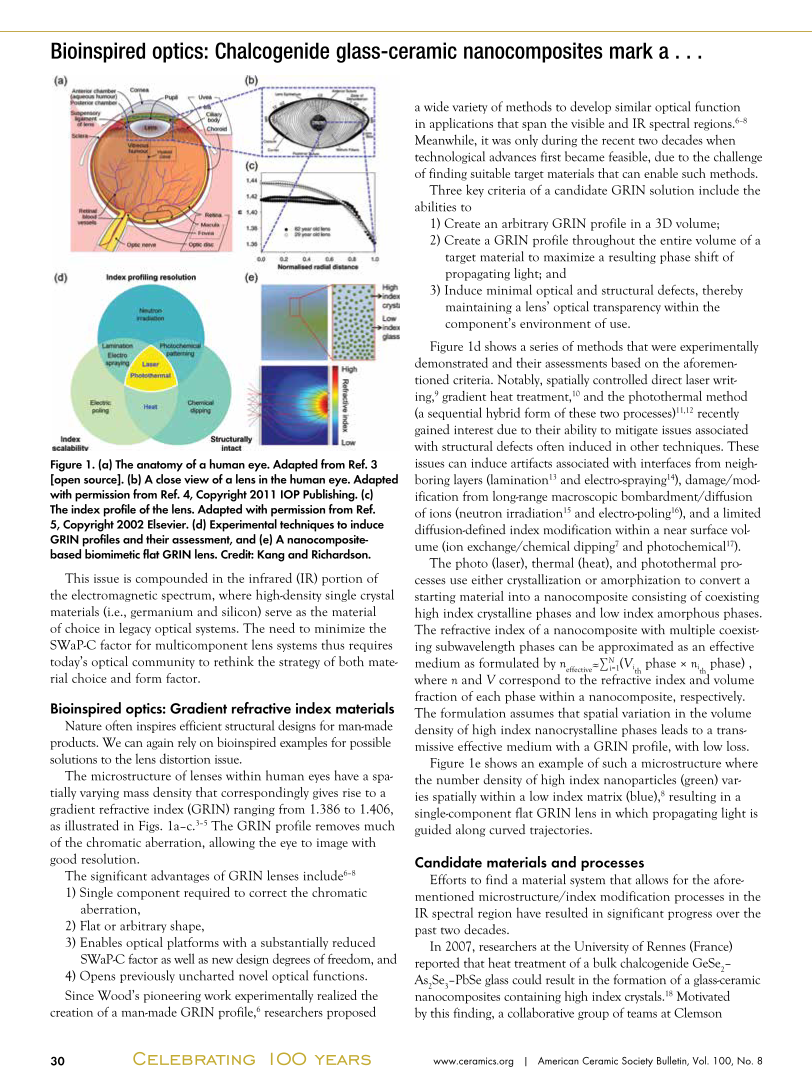www.ceramics.org | American Ceramic Society Bulletin, Vol. 100, No. 8 30 Bioinspired optics: Chalcogenide glass-ceramic nanocomposites mark a . . . Celebrating 100 years This issue is compounded in the infrared (IR) portion of the electromagnetic spectrum, where high-density single crystal materials (i.e., germanium and silicon) serve as the material of choice in legacy optical systems. The need to minimize the SWaP-C factor for multicomponent lens systems thus requires today’s optical community to rethink the strategy of both mate- rial choice and form factor. Bioinspired optics: Gradient refractive index materials Nature often inspires efficient structural designs for man-made products. We can again rely on bioinspired examples for possible solutions to the lens distortion issue. The microstructure of lenses within human eyes have a spa- tially varying mass density that correspondingly gives rise to a gradient refractive index (GRIN) ranging from 1.386 to 1.406, as illustrated in Figs. 1a–c.3–5 The GRIN profile removes much of the chromatic aberration, allowing the eye to image with good resolution. The significant advantages of GRIN lenses include6–8 1) Single component required to correct the chromatic aberration, 2) Flat or arbitrary shape, 3) Enables optical platforms with a substantially reduced SWaP-C factor as well as new design degrees of freedom, and 4) Opens previously uncharted novel optical functions. Since Wood’s pioneering work experimentally realized the creation of a man-made GRIN profile,6 researchers proposed a wide variety of methods to develop similar optical function in applications that span the visible and IR spectral regions.6–8 Meanwhile, it was only during the recent two decades when technological advances first became feasible, due to the challenge of finding suitable target materials that can enable such methods. Three key criteria of a candidate GRIN solution include the abilities to 1) Create an arbitrary GRIN profile in a 3D volume 2) Create a GRIN profile throughout the entire volume of a target material to maximize a resulting phase shift of propagating light and 3) Induce minimal optical and structural defects, thereby maintaining a lens’ optical transparency within the component’s environment of use. Figure 1d shows a series of methods that were experimentally demonstrated and their assessments based on the aforemen- tioned criteria. Notably, spatially controlled direct laser writ- ing,9 gradient heat treatment,10 and the photothermal method (a sequential hybrid form of these two processes)11,12 recently gained interest due to their ability to mitigate issues associated with structural defects often induced in other techniques. These issues can induce artifacts associated with interfaces from neigh- boring layers (lamination13 and electro-spraying14), damage/mod- ification from long-range macroscopic bombardment/diffusion of ions (neutron irradiation15 and electro-poling16), and a limited diffusion-defined index modification within a near surface vol- ume (ion exchange/chemical dipping7 and photochemical17). The photo (laser), thermal (heat), and photothermal pro- cesses use either crystallization or amorphization to convert a starting material into a nanocomposite consisting of coexisting high index crystalline phases and low index amorphous phases. The refractive index of a nanocomposite with multiple coexist- ing subwavelength phases can be approximated as an effective medium as formulated by n effective ≈∑N i=1 (V i th phase × n i th phase) , where n and V correspond to the refractive index and volume fraction of each phase within a nanocomposite, respectively. The formulation assumes that spatial variation in the volume density of high index nanocrystalline phases leads to a trans- missive effective medium with a GRIN profile, with low loss. Figure 1e shows an example of such a microstructure where the number density of high index nanoparticles (green) var- ies spatially within a low index matrix (blue),8 resulting in a single-component flat GRIN lens in which propagating light is guided along curved trajectories. Candidate materials and processes Efforts to find a material system that allows for the afore- mentioned microstructure/index modification processes in the IR spectral region have resulted in significant progress over the past two decades. In 2007, researchers at the University of Rennes (France) reported that heat treatment of a bulk chalcogenide GeSe 2 – As 2 Se 3 –PbSe glass could result in the formation of a glass-ceramic nanocomposites containing high index crystals.18 Motivated by this finding, a collaborative group of teams at Clemson Figure 1. (a) The anatomy of a human eye. Adapted from Ref. 3 [open source]. (b) A close view of a lens in the human eye. Adapted with permission from Ref. 4, Copyright 2011 IOP Publishing. (c) The index profile of the lens. Adapted with permission from Ref. 5, Copyright 2002 Elsevier. (d) Experimental techniques to induce GRIN profiles and their assessment, and (e) A nanocomposite- based biomimetic flat GRIN lens. Credit: Kang and Richardson.
(c) 2024 American Ceramic Society. All Rights reserved.




















































